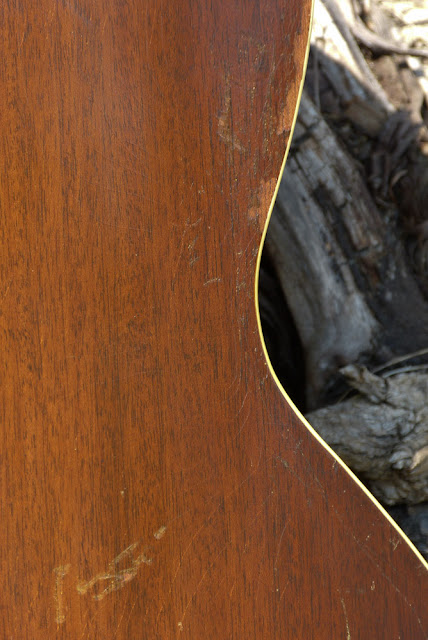1930s Vega Style B Cylinder-Top Guitar
There's nothing quite-so-nice as a high-class guitar with a high-class sound. I swear -- there were 4 or 5 of my customers (and myself) watching this guitar as it ticked-down on eBay. One of my customers with a number of instruments for repair over here picked it up and it was sent-on to me. Lucky, aren't I? Well, of course he had me bump it up in the queue, so I even had an excuse to get it done on-the-quick.
Vega (of Boston) cylinder-top instruments are, to put it bluntly, very rare. I see the mandolin-family variants once in a while but the guitars barely ever pop up for sale. This one appears to be a style B with mahogany back and sides and a "reverse brownburst" finish. It's roughly the size of a 12-fret 00 (14" lower bout), though it has a 14-fret neck. The serial number points to 1920 but the instrument itself is definitely early 30s.
The "reverse brownburst" finish is pretty interesting in its own right.
The top is solid spruce and the back, sides, and neck are solid mahogany. The board and bridge are ebony. This has a "cylinder" top and back and has been spared any cracks save for a nasty, handyman-repaired crack on the bass side. The build is light and extremely precise (as you'd expect from Vega -- these guys were every bit as good at their work as Martin employees).
In the hands and on the knee it feels sort-of like a supercharged L-00 -- tonally, however, it's very-much its own thing. Having a pin-bridge load on what's essentially an archtop, the guitar responds in a way most archtops would love to say they do -- it has an almost D-18-ish crisp, big, focused bottom-end with the punchy, gutsy sound of a good carved-top guitar on the top end. It's also very loud for its size and would easily hold its own alongside carved-top guitars of the day. I'll say it simply: this guitar is what every round-hole archtop guitar wants to be but isn't... quite.
The headstock is very spare but does have an ebony veneer and bone nut. The nut is right between 1 11/16" and 1 3/4" -- it's hard to measure precisely with the sloping edges of the board.
The scale is 25" and the board has a 12" radius. Due to neck warp, I had to level the board and refret it -- which I did with medium stock. It always feels good to have fresh frets! Note the side dots and pearl face-dots.
The neck profile itself is a comfortable, mild-medium C-shape -- liike a 30s Martin but rounder.
I have this strung-up with a mix that runs 52w-12 but has gauges "voiced" to the instruments midrange. The actual tension is a little lighter than most "12s" sets.
Check out the attention to detail on that crisp rosette!
The original bridge layout would've been a simple rectangle. At some point the original saddle area must've blown-out because that section was filled-in (you can see it near the low E) by some unknown repairman and an extra wedge of ebony was installed in front of it. To top it off a random piece of steel was set (uncompensated) in the bridge as a saddle.
I leveled the top surface of the bridge down until the funk of the old modifications was (more or less) gone, then cut a new saddle slot. It didn't turn out 100% as I'd hoped as the old in-fill of the burst-out area of the bridge was -- hmm, "foamy?" -- not exactly like cutting the real stuff, here and there, where it wanted to chip.
Still, all is seated well, now, and it beats having to make a new ebony bridge and fitting it to the top. The saddle is low but, considering the neck's level geometry with the fretboard extension, I figured a reset wasn't entirely in order.
As you'd expect, Vega fit and finish is top-notch.
The back and sides have a "shaded" finish as well. Note all the use-wear back here.
There were two light hairline cracks along the line of the tuners -- which I glued-up -- and they seem to be holding just fine.
I like that elegant little "lip" volute -- don't you?
Here's the ugly bit -- a long crack on the bass side of the guitar. It's thankfully on the "knee" side, but the frustrating part is the egregious amount of glue used to put it back together in the past -- and not terribly well-matched. I decided to let sleeping dogs lie.
Gorgeous, no? This is what makes this instrument so unbelievably special.
However -- Mr. "I'll put a strap button anywhere and everywhere," might disagree (one in the heel, one on the side).
While most Vega serial numbers seem to match up to dates associated with the banjo numbers, this guitar number clearly does not.





















Comments